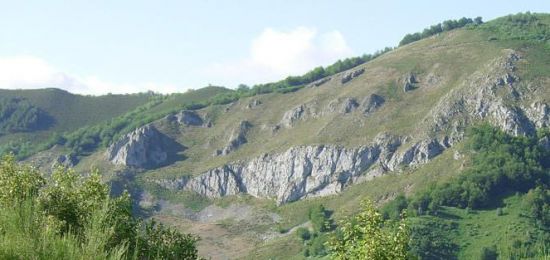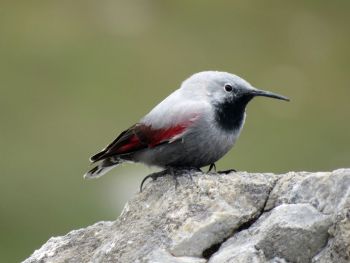
Photo © by madamcoolpix
Asturias, Spain, 9 August 2007
Overview
The Picos de Europa is a limestone massif close to the northern coast of Spain that is becoming increasingly popular with birding visitors and also attracts many people interested in the vast array of wild flowers to be seen in the alpine meadows.
Large parts of the Picos de Europa range are now under protection as national parks or national reserves. Covadonga was established in 1918 as Spain's first national park and is situated on the western flank of the Picos de Europa.
Saja-Besaya Nature Reserve [4] is on the eastern side and is Spain's largest national reserve. Despite a reputation for being frequently wet and misty, this is an area of exceptionally beautiful scenery with a good variety of mountain and forest birds. These mountains cover a wide range of habitats including glacial lakes, rocky outcrops, cliffs and gorges and bare mountain peaks at over 2500m.
There are large areas of subalpine grassland, heathland where the forest has been cleared, and lowland hay meadows. The forests are now much reduced but beechwoods remain on the higher slopes, replaced by oakwoods lower down consisting of Pedunculate Quercus robur, Sessile Q. petraea and Pyrenean Q. pyrenaica Oaks. Forests of Yew Taxus baccata still occurs in some of the dry, sandy valleys.
Birds
Notable Species
Birds found in this area include a good range of breeding raptors such as Griffon Vulture and Egyptian Vulture, Bonelli's Eagle on passage. Wallcreeper and Iberian Chiffchaff are among the passerines. Green Sandpiper can be seen on passage.
Little Grebe, Common Pochard and Mallard occur around the lakes, Pied Avocet on the reservoir at Riano, and Common Dipper and Grey Wagtail along the many streams.
History and Use
The Picos de Europa is a limestone massif close to the northern coast of Spain. Large parts of the Picos de Europa range are now under protection as national parks or national reserves.
Access and Facilities
The Picos de Europa range is situated in north-central Spain. The Covadonga National Park can be reached from the village of Cangas de Onis.
Check-list
Birds you can see here include:
Little Grebe, Black Stork, White Stork, Common Teal, Mallard, Common Pochard, European Honey Buzzard, Black Kite, Egyptian Vulture, Griffon Vulture, Short-toed Eagle, Hen Harrier, Montagu's Harrier, Eurasian Goshawk, Eurasian Sparrowhawk, Common Buzzard, Golden Eagle, Bonelli's Eagle, Booted Eagle, Common Kestrel, Peregrine Falcon, Western Capercaillie, Grey Partridge, Common Quail, Eurasian Coot, Pied Avocet, Common Redshank, Green Sandpiper, Common Sandpiper, Eurasian Woodcock, Common Woodpigeon, Eurasian Collared Dove, Common Cuckoo, Great Eagle Owl, Tawny Owl, Common Swift, European Bee-eater, Eurasian Hoopoe, Eurasian Wryneck, Iberian Green Woodpecker, Black Woodpecker, Great Spotted Woodpecker, Middle Spotted Woodpecker, Lesser Spotted Woodpecker, Wood Lark, Eurasian Skylark, Eurasian Crag Martin, Barn Swallow, Western House Martin, Tree Pipit, Meadow Pipit, Water Pipit, Grey Wagtail, White Wagtail, Common Dipper, Common Wren, Dunnock, Alpine Accentor, Eurasian Robin, Black Redstart, Common Redstart, European Stonechat, Northern Wheatear, Western Black-eared Wheatear, Rufous-tailed Rock Thrush, Blue Rock Thrush, Ring Ouzel, Eurasian Blackbird, Song Thrush, Redwing, Mistle Thrush, Cetti's Warbler, Melodious Warbler, Western Subalpine Warbler, Sardinian Warbler, Common Whitethroat, Blackcap, Garden Warbler, Western Bonelli's Warbler, Iberian Chiffchaff, Goldcrest, Common Firecrest, Spotted Flycatcher, European Pied Flycatcher, Long-tailed Tit, Marsh Tit, Coal Tit, Crested Tit, Blue Tit, Great Tit, Common Treecreeper, Short-toed Treecreeper, Eurasian Nuthatch, Wallcreeper, Eurasian Golden Oriole, Red-backed Shrike, Woodchat Shrike, Common Jay, Alpine Chough, Red-billed Chough, Carrion Crow, Northern Raven, Spotless Starling, House Sparrow, Rock Sparrow, White-winged Snow Finch, Chaffinch, European Serin, Citril Finch, European Greenfinch, European Goldfinch, Eurasian Linnet, Common Crossbill, Common Bullfinch, Hawfinch, Yellowhammer, Cirl Bunting, Ortolan Bunting, Rock Bunting, Reed Bunting, Corn Bunting
Other Wildlife
The now very rare Spanish subspecies of both Brown Bear Ursus arctos and Wolf Canis lupus survive in these mountains as well as other carnivores including Wildcat Felis silvestris, Red Fox Vulpes vulpes, Genet Genetta genetta, Polecat Mustela putorius, Badger Meles meles, Pine Marten Martes martes and Beech Marten Martes foina with European Mink Mustela lutreola and Otter Lutra lutra in the wetter areas. Also found here are Garden Dormouse Eliomys quercinus, Wild Boar Sus scrofa, Roe Deer Capreolus capreolus, Fallow Deer Dama dama, and Red Deer Cervus elaphus, and in the higher parts, a thriving population of Pyrenean Chamois Rupicapra pyrenaica. The mountains are a stronghold of the rare Pyrenean Desman Galemys pyrenaicus.
The flower-filled grasslands attract a wide variety of butterflies include several endemic races. The Cantabrian race of Gavarnie Blue Agriades pyrenaicus asturiensis and Chapman's Ringlet Erebia lefebvrei are Picos de Europa specialities and Spanish Argus Aricia morrocensis and the Iberian and North African race of Scarce Swallowtail Iphiclides podalirius feistamelii can also be seen.
The grasslands of the Picos de Europa are among the richest in Europe in terms of floristic diversity. Orchids are particularly varied with over 40 species recorded including such spectacular species as Pink Butterfly Orchis papilionacea, Lizard Himantoglossum hircinum, Man Aceras anthropophorum, Woodcock Ophrys scolopax, Bee Ophrys apifera, Fly Ophrys insectifera and Tongue Serapias lingua Orchids. Other striking flowers to be found here include Hoop-petticoat Daffodil Narcissus cantabricus, White Asphodel Asphodelus albus and Pyrenean Lily Lilium pyrenaicum.
The beechwoods also have an interesting flora including Spurge Laurel Daphne laureola and Green Hellebore Helleborus viridis, Bilberry Vaccinium myrtillus and Kidney Saxifrage Saxifraga hirsuta, and higher woodlands have Oxlip Primula elatior, Bulbous Corydalis Corydalis bulbosa and Dog's-tooth Violet Erythronium dens-canis. The localised St Dabeoc's Heath Daboecia cantabrica occurs on the heathlands.
Site Information
Areas of Interest
Cares Gorge
The spectacular gorge at Cares can be reached on the Poncebas road from Arenas de Cabrales. Hotel and pension accommodation can be found at Cangas de Onis or Posada de Valdeon. There are campsites and a hostel beside the lakes in Covadonga National Park. The refuges at Vega de Ario and Vegarredonda provide food and accommodation.
Saja-Besaya Nature Reserve
Cabezon de la Sal provides a good base for Saja-Besaya Nature Reserve and can be reached on the N634. From here the C625 runs through the Saja river valley to the Palombera pass. In the east of this reserve is Fuente De, a popular birding site for high-altitude species that can be reached by cable-car from nearby Espinama. Cabezon de la Sal has a good range of hotels and accommodation can also be found at Renedo de Cabuerniga, Barcena Mayor and the ski-resort at Brana Vieja. There are campsites at Ucieda, Barcena Mayor and Saja.
Access and Facilities
The Picos de Europa range is situated in north-central Spain roughly midway between the towns of Oviedo and Santander. The Covadonga National Park can be reached from the village of Cangas de Onis, take the 6312 and turn off for Covadonga at Soto de Cangas.
There is an information centre at Oviedo and the park has resident wardens, nature trails and refuges.
References
- eBird
- Spain's National Parks
- Cares Gorge Trail
- Saja-Besaya Nature Reserve
- Picos de Europa National Park
- Asturias Region
Recommended Citation
- BirdForum Opus contributors. (2025) Picos de Europa. In: BirdForum, the forum for wild birds and birding. Retrieved 18 May 2025 from https://www.birdforum.net/opus/Picos_de_Europa
Maps
External Links
GSearch checked for 2020 platform.1
Content and images originally posted by Steve
Reviews
Rob Williams's review
I went to northern Spain at the end of July into August. This was a family holiday with some birding thrown in where possible. I stayed near the coast at Posada de Llanes, a large village near the foothills of the Picos, in an apartment, one of 14. As soon as we arrived two wrens flew around our small area of garden. In the fortnight in that garden I also saw yellowhammer, robin, blackbird, garden warbler, melodious warbler, blackcap, goldfinch with swallows and swifts. Flying overhead daily were buzzard and, I believe, but cannot be sure, Bonelli's Eagle. Nearby were seen jay, black redstart, more buzzard and black kite. Although not far away, the cable car at Fuente De took 1.5 hours, driving through some spectacular gorges with breathtaking scenery. The cable car takes you to 1800 metres and we walked to the summit hotel, nominally 4km away. Here we saw approx a dozen Griffon Vulture circling, 2 immature golden eagle, wheatear, crag martin, alpine swift, housemartin, alpine chough, snowfinch. Unfortunately, no wallcreeper, but you cannot have it all. If you do this trip, be prepared for some chaos coming back down on the cablecar and remember to get your tickets stamped as soon as you arrive back at the station, as this determines the length of your wait. Also beware that the ticket numbers are shouted out in Spanish only in a cavernous corridor! If you go when the bulk of Spain goes on holiday, approx 9 August we found, the queue to go up the mountain is 3-4 hours, the week before, no queue. I would definitely go to this part of Spain again, very friendly people willing to mix their little bit of English with your bit of Spanish, marvellous countryside and no rip-off culture.
Pros
- Stunning Scenery
- good bird life
- not too touristy
Cons
- Crowded when the Spanish Holidays start
wallcreepers's review
We arrived in the Picos hoping to see a Wallcreeper! We wanted to avoid relying on the well documented Feunte De cable car route if possible. Staying in Arenas de Cabrales it was a short drive to Poncebos where our walk began. At this point you can also start the Carres Gorge walk. We were walking to the tiny village of Bulnes. It is a truly lovely walk and after about an hour when we could just see the houses appearing on top of the hill, about 400 meters from the village we saw our bird. It showed well for about five or ten minutes on an outcrop of rocks just above the path to our left, before flying around the back of the outcrop not to be seen again. We were more than happy and did not give chase. Other good birds seen on the trip were mainly spotted from the campsite, as this was more of a family holiday than a birdwatching trip. These included two dipper in the river below our caravan, one fleeting kingfisher, two golden eagles above the hill on the other side of the river and one goshawk a little lower down the hill. Would certainly visit again for a more bird oriented holiday, probably in spring next time. Of course now the wallcreeper has at long last been found there is no rush!
Pros
- Beautiful
- easily accessible mountainous areas
Cons
- Does rain a lot





